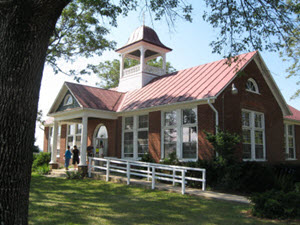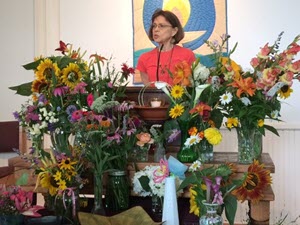
HUU Sermon Archives
Fire: The Light Within and Without
by Elizabeth Ihle
June 22, 2003
 This
morning, the solstice, we celebrate fire, the third of the four elements of earth,
air, fire, and water memorialized by the ancients as the basic elements of creation.
Summer Solstice, also known as Litha or Midsummer's Night, is the longest day and
shortest night of the year. For you brave souls who spent the night camping out
at HUU, you are probably keenly aware of how truly short this past night was. At
this zenith of earthly light, the Solstice marks the peak of the year's waxing half.
In a sense, today is the balance of the year. From here on the days get shorter,
the nights longer, and the dark side begins to take over the cycle. In most folks'
calendars today is the first day of summer. In the pagan calendar, however, today
is not the beginning of summer but its midpoint, and such a division makes sense.
This is the time of the Earth at the fullness of her strength, sexuality, and fertility.
The crops in fields are in full bloom now, or past blooming, the grain forms on
the stalk and the ear. The harvest is promised but is still far away in the future.
For the pagans, today is the midpoint of the growing season. We don't have much
information about how the pagans celebrated Midsummer, but considering that Stonehenge
was oriented toward the sunrise on the summer solstice, it's apparent that many
of our ancestors considered this a pivotal day.
This
morning, the solstice, we celebrate fire, the third of the four elements of earth,
air, fire, and water memorialized by the ancients as the basic elements of creation.
Summer Solstice, also known as Litha or Midsummer's Night, is the longest day and
shortest night of the year. For you brave souls who spent the night camping out
at HUU, you are probably keenly aware of how truly short this past night was. At
this zenith of earthly light, the Solstice marks the peak of the year's waxing half.
In a sense, today is the balance of the year. From here on the days get shorter,
the nights longer, and the dark side begins to take over the cycle. In most folks'
calendars today is the first day of summer. In the pagan calendar, however, today
is not the beginning of summer but its midpoint, and such a division makes sense.
This is the time of the Earth at the fullness of her strength, sexuality, and fertility.
The crops in fields are in full bloom now, or past blooming, the grain forms on
the stalk and the ear. The harvest is promised but is still far away in the future.
For the pagans, today is the midpoint of the growing season. We don't have much
information about how the pagans celebrated Midsummer, but considering that Stonehenge
was oriented toward the sunrise on the summer solstice, it's apparent that many
of our ancestors considered this a pivotal day.
On the altar this morning, I have arranged some objects representing the ancient elements and the directions. For the north I have yellow flowers, symbolizing earth; for the east, here's a feather representing air; a pitcher of water represents the west, and for the south, our focus today, is a candle symbolizing fire. Let's also remember that fire—as in our chalice and as symbol of enlightenment—is particularly symbolic to Unitarian-Universalists.
As I began to think about doing this series of sermons on the ancient elements, I thought only about focusing on the elements themselves and their meanings. Here it is, the third of these four sermons, and I am only realizing now the importance of balance in dealing with them. My mother has always told me that the optimum is the moderation between extremes, and our recent weather and some of the research I've done for this service has underscored her point. For four long summers I have promised myself never to complain about too much rain, but maybe this summer I may have to change my mind. The longing for a sunny day has now usurped my wish for rain. My momma is right: we need balance. So today we celebrate the sun, but just like the rain we are now experiencing the sun and its fire too can be too much of a good thing. Let's not forget the past four long, hot, dry summers.
As we focus on the sun and the light, I'd like to talk about the fire outside and within our lives. First about the effect of global warming and fire on plant and animal life, then a little about the sun and circadian rhythms on monarch butterflies and ourselves, and finally about the fire within, the fire in our souls and in our human relationships.
There's no ignoring the sun as the engine that drive the Earth and all its life. Lift up your head on a clear morning, and you will see the great sacred fire rising to the east. “We live,” says poet Wallace Stevens, “in an old chaos of the sun/Or old dependency of day and night,” and so does every living thing, past, present, and future. Most human beings picture nothingness as being cold and dark; since we first looked up into the sky we have been chanting our devotion to the sun. In the first sacred books of Hinduism, the Rig-Veda, written more than three thousand years ago, the Divine itself was created by heat:
In the beginning was darkness swathed in darkness;
All this was but unmanifested water.
Whatever was, the One, coming into being.
Hidden by the Void,
Was generated by the power of Heat.
That great fiat “Let there be light” set the ball rolling, started the flow of energy that made life possible and has echoed through the ages every since.
Last year 2002 edged out 1999 as the second warmest year on record, after 1998; I'll save the effect of global warming on the seas until another time, but warming trends do much more than cover up more land. As our ozone layer thins and more sunlight reaches us, changes to our earth will accelerate. Two recent studies indicate that global warming will alter species' habitat and behavior. Alastair H. Fitter, professor of biology at the University of York in Great Britain, has documented that flowers are blooming earlier than ever before and concluded that ranges of hundred of species are shifting northward in response to warming temperatures; although the temperature climb is modest (1 degree in the past century), plants and animals are already being affected.
A United National panel has predicted that average global temperatures could rise as much as 10.5 degrees Fahrenheit over the next century as heat-trapping gases from human industry accumulate in the atmosphere. The result of this warming is that some plant and animal species may be driven into extinction as their ranges shrink or they are forced to compete with other species moving into their territory. If we value life on earth as it is now, too much sun is not a good thing.
Besides the sunlight from the sky, another kind of warming is fire, which can be both good and bad for life as we know it. I've been recently reading a book about birds that have become extinct in North America. Fire was a major player in the extinction of the Heath Hen on Martha's Vineyard off the coast of Massachusetts. The Heath Hen, an eastern relative of the still extant Greater Prairie Chicken, was so abundant in New England when the colonists arrived in the early 1600s that it was routinely eaten and used as target practice. It flew in a straight line to low tree branches, making it an easy mark for beginning hunters. However, our rapacious culinary and sharp shooting appetites put an end to the Heath Hen everywhere in the northeast by the late 1800s except on Martha's Vineyard. Although Massachusetts acted pretty responsibly and mounted a major campaign at the time to save the Heath Hen and set aside a reserve for it on the Vineyard, a major fire begun by a carelessly thrown cigarette swept the reserve on May 12, 1916, the middle of nesting season. The fire burned 13,000 acres, about 20% of the entire island, including the majority of the scrub-oak barrens that the Heath Hens needed for successful nesting. It killed the vast majority of the last 2000 Heath Hens themselves. Although some survived and the last Heath Hen didn't die until 1932, that fire doomed that bit of animal biodiversity to extinction. It's a good example of the destructive and often irreversible power of fire.
Yet fire is a source of renewal too. Americans are becoming more aware that total fire suppression is not a good policy. The decision of the National Park Service to allow naturally ignited fires to burn when human habitat in not in danger is a wise one. Fire can create or recreate ecological niches for a variety of plants and animals. Back on Martha's Vineyard, the Nature Conservancy burned some 400 acres on the island in 1999, and some flames were 50 and 60 feet high. The fire was so hot that it actually melted some of the equipment used to monitor the burn. It burned the Scrub Oaks, but now they're back because their root systems can withstand a fire as hot as 2000 degrees. That fire and others promoted the growth of such desired plants as the wildflower Blazing Star and providing the scrubby habitat needed for the Short-Eared Owl. It assisted the breeding of a rare version of the Grasshopper Sparrow and the return of Butterfly Weed and an orchid knows as Early Ladies Tresses. A happy note is that conservationists are now studying the genetic similarities of the Heath Hen and the Greater Prairie-Chicken. If the genetics are a close match, the latter will be gradually introduced to the island as a replacement for what fire destroyed nearly a hundred years ago.
The monarch butterfly offers us a good transition from the fire without to the fire within. Monarchs, which as you probably already know, overwinter in the mountains of Mexico and then emigrate as far north as Winnipeg, Canada. Three or four generations later, nearly 100 million of the migrants' descendants—with no clue where their ancestors came from—emerge from chrysalises in early September and begin a 22 month flight back to Mexico. They use the fire without, the sun, to navigate. Somehow, a monarch in Georgia knows to fly 270 degrees due west to get to Mexico, while a monarch at the same latitude in Texas knows to go 220 degrees southwest. The sun serves as a steady beacon, a certainty in the very uncertain world of monarchs, guiding this frail insect to the safety of winter habitat.
We humans share a critical part of the monarchs' extraordinary ability to migrate, another kind of fire within: circadian rhythms. This is also known as the biological or body clock, and is a regulatory mechanism within virtually all animals—including us humans—that allows animals to adjust cycles of rest and activity to the solar day. The word circadian derives from the Latin phrase “circa diem”, which means about a day. The clock runs all the time but is periodically reset to keep it synchronized with the varying cycles of light and darkness. The monarchs use a keen circadian rhythm to orient themselves toward the sun and migration times. Butterflies released in Massachusetts somehow know the morning sun ought to be over their left shoulders in order for them to fly southwest. We humans have a circadian rhythm too and react to the sun. Through travel we have learned that the bigger the disturbance to our cycle, the longer it takes to reset. Jet lag, for instance, requires a more serious adjustment than daylight-savings time. Here at the Solstice, thanks to our circadian rhythms, many of us sleep less than we do in the darkness of winter.
Although our circadian rhythm is just one example of the fire within us humans, it's certainly not the only one. Another physical example of our fire within is our ability to regulate our body temperature. But enough of that. It's time to turn to our spiritual fires.
It's probably not great leap of reason to assume, as did Hildegarde of Bingen, that great medieval abbess, that the life-force within us can also represented by fire or light. We often see references to people or perhaps other creatures as “glowing with life”. There's nothing like the sun shining through the air in the woods in early morning to help us sense life in every cell and pore. This life-force quickens us to action and changes inert matter into something living. It's truly a miracle.
We often talk about the fire in human relations. “Light my fire!” “A fiery temper.” “All fired up.” “Fire in the belly.” “The spark of love.” “The spark of human kindness.” “Burning with desire.” “Burnt out.” And again, even our verbal imagery underscores the need for balance.
The passion we feel for some people, and the com-passion we feel for many people are beautiful, essential elements for quality personal and social lives. We admire those with fire and passion that are appropriately expressed. We each use the fire within us to connect with our family and friends around us. We use our fire to quicken us to action. It is a good fire. At the same time, we often rightly fear our fellow humans when the fires of their beliefs or passion have burned away common sense and inhibition. The fire within can become destructive. Many of us become burnt out by daily work or routine. So once again, we need a balance—a spiritual fire to warm and comfort us but not a raging blaze that envelops us.
So as we close this morning, let us celebrate the sun, the fire without, and the fire within our souls. Let us leave this morning, letting our light shine everywhere we go and building up a compassionate and just world. So may it be.
Read more sermons or talks by Elizabeth Ihle.
- Little Cabin in the Woods
- Come to My Garden: 2002 Flower Communion
- Fire: The Light Within and Without
- Hildegard of Bingen: A Medieval Mystic for the Modern Age
- Katrina Sermon
- Thank Heavens for Mother Earth!
- Thanksgiving: An American Tribal Holiday
- Washin' in the Water, Goin' with the Flow
- Sacred Spaces
For the latest sermons and events at HUU, visit our Community Cafe.
Inclement
Weather Policy
Worship
Service Materials
Curret Newsletter


UUs on YouTube
Our denomination has an official presence on YouTube! The Unitarian Universalist Association's YouTube site includes several videos and lots of interesting commentary.
Harrisonburg Unitarian Universalists 4101 Rawley Pike | Harrisonburg,
VA 22801
Mailing Address: | PO Box 96 | Harrisonburg, VA 22803
| (540) 867-0073 | Webmaster
HUU is a member of the Southern
Region of the Unitarian Universalist
Association
Privacy Policy &
Disclaimer
Site Design & Maintainence : Expression
Web Tutorials & Templates


